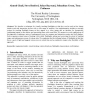Free Online Productivity Tools
i2Speak
i2Symbol
i2OCR
iTex2Img
iWeb2Print
iWeb2Shot
i2Type
iPdf2Split
iPdf2Merge
i2Bopomofo
i2Arabic
i2Style
i2Image
i2PDF
iLatex2Rtf
Sci2ools
INTERACT
2003
2003
Visually-tracked Flashlights as Interaction Devices
: We describe a technique for visually tracking flashlights so that they can be used as fun, cheap, intuitive and safe interaction devices with a wide range of surfaces. Our implementation includes a run-time system for tracking flashlight beams as they appear in a video image and an interface for dynamically configuring targets on the surface and associating them with sound files. We present two early applications of this approach: exploring a series of underground caves at a museum and interactive posters and wall displays. Early experience raises issues of dealing with wobbly flashlights, setting and conveying the extent of tracking range, and making users aware of system state. We emphasise that the defining feature of flashlights is that they throw a pool of light and suggest various ways in which this can be exploited to improve the flexibility of this approach.
| Added | 31 Oct 2010 |
| Updated | 31 Oct 2010 |
| Type | Conference |
| Year | 2003 |
| Where | INTERACT |
| Authors | Ahmed Ghali, Steve Benford, Sahar Bayoumi, Jonathan Green, Tony P. Pridmore |
Comments (0)

